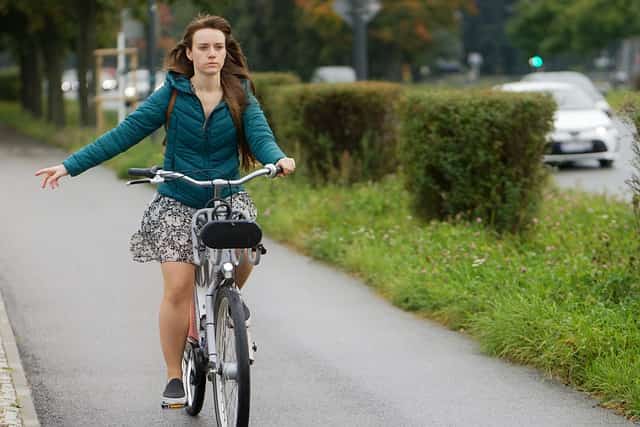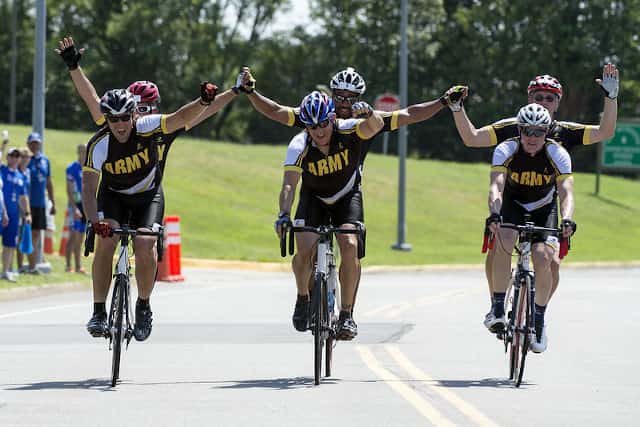Once you have learned to ride a bike, then the next natural step in the process is cycling one handed. For some, riding a bicycle with only one hand is considered the first real trick.
But for many others, riding with one hand allows the cyclist to multitask. With enough practice and dedication, anyone can learn to ride a bicycle with only a single hand.
Riding with one hand is easier than you think. In fact, most people who have never ridden before can do it. You don’t need to be an expert rider to ride with one hand. All you need is some practice and patience.
Here are three tips to help new riders learn how to ride with one hand:
1. Practice in a safe place where there aren’t any cars or other vehicles that could hit you.
2. Start by practicing at slow speeds until you feel comfortable.
3. Once you’re ready, try riding around your neighborhood.
Learn How to Ride with One Hand
When it comes to learning how to ride with one hand, there are a series of progressions that every cyclist should take. The first step is to pedal up to a comfortable speed while going in a straight line for at least 10 to 30 feet.
From there, lift one hand up, but only hover it a few inches above the handlebars. If you feel that the bike is becoming unstable, you can quickly return the hand to the grip.
Next, begin switching back and forth between hands, keeping one hand on the handlebar at all times, with the other hand hovering only inches above it.
Use your inner thighs to grip the seat in order to maintain balance, and use your hand simply to steer. The centrifugal force created by the wheels will keep the bike upright.
Practice Riding with One Hand
Once you have become more comfortable with hovering your hands only inches above the handlebars, you can begin removing one hand altogether.
Rather than hovering the hand above the handlebars, lower your arm down to your side. When doing this you will need to shift your weight so that your other hand is able to maintain control over the bicycle.
Continue to use your inner thighs to grip the seat, in order to maintain balance as you move your hand back and forth from the handlebars.
Like with the hovering exercise, you can begin to alternate between hands, allowing each arm to build up the necessary strength to maintain control over the bike.
Ride with Confidence
In order to build up confidence in your ability to ride a bicycle, you will need to spend more time riding. Confidence is all about understanding the limits of the bicycle and yourself.
And, the only way that you can truly understand the limits of your bike, is to spend more time on it. Eventually, you will begin to develop enough confidence to try very basic tricks.
One of the best ways to build up confidence is to spend time with other cyclists. Regardless of where you live, you are bound to find a number of other people who simply love spending their mornings on a bicycle.
You can partner up with them and go for rides which will give you more opportunities to strike up a conversation. You will find in no time that your confidence levels will increase substantially.
Letting Go Of Your Anxieties
Almost all new cyclists get anxious when they go for a ride. After all, just about anything could happen.
There are so many horror stories about cyclists being struck by vehicles going down the road, or freak accidents that result in the rider going over the handlebars.
All cyclists think about this potential for disaster, but the difference between a beginner and a professional is that professionals are able to let go of those anxieties.
Everyone has fallen off a bicycle at least once in their life. The inevitability of an accident results in emotional scars that may take time to heal.
It’s not uncommon for a kid who takes a spill, to push their bike home rather than ride it.
There may be nothing wrong with the bicycle itself, yet as a result of the emotional scarring caused by the accident, they cannot find the courage to climb back on the bicycle and ride it home.
Don’t Worry About Falling Off
The fact is, that accidents will happen more often when you are a beginner. Even professionals take spills all the time. Think about the last time you watched a road race on television and saw a pile of cyclists go over their handlebars because of overcrowding.
The difference is, that professionals are able to let go of their anxieties and get back on the bike to finish the race.
To the professional, the desire to win the race forces them to climb back on even after a bad spill. But, for the regular cyclist, there is no need to immediately jump back on the bike.
Instead, it’s important to take the time to pause and reflect on the accident, and how it could have been prevented. You need to take the time to relax and focus on calming your nerves.
It may take you a few minutes, but eventually, the adrenaline will wear off, and you can straddle the bike once again to ride it home.
Naturally, the next time you get on bike, you will think about your last spill and begin to worry about falling off again. But do not let these worries get you, or you will never be able to convince yourself to ride again.
Instead, straddle the bike with your feet touching the ground, and scoot yourself along the ground rather than peddling. You will find that within a few minutes, your anxieties will fade away, and you will begin to feel more comfortable with riding the bike again.

How to Balance Your Bike While Signaling
When it comes to riding in traffic, it’s important to make sure to signal your intentions to other vehicles. However, in order to properly signal you will need to be able to remove one hand from the handlebar.
For most beginners, and even those who have not ridden a bike in years, simply taking a single hand off of the handlebars is enough to cause panic.
As a result, the signals sent are generally not recognized by others on the road.
Start by hovering your hands, then practice with your arms down to your side. When you are ready to try signaling for the first time, you need to hold your entire left arm out straight, including all of your fingers.
Many beginners tend to keep their hands enclosed in a fist, or even point in the direction they are turning, but the fingers should be outstretched. This will inform others on the road that you are planning on turning left.
Practice holding out your right arm
Next, you can practice holding out your right arm, with your fingers fully outstretched to inform traffic behind you that you are planning on turning right.
After you become more comfortable using the right arm to signal a right turn, you can begin to practice using your left arm to signal a right turn.
This is done by keeping the elbows level with the shoulder, and raising the hand with the fingers stretched out towards the sky.
The next signal to practice is “stop”. The only way to signal to other vehicles that you are stopping is to hold your elbow straight out from your shoulder, with your fingers stretched towards the ground.
When done properly, other vehicles on the road behind you will be able to identify that you are planning on stopping. Right before you stop however, you can lower your left arm all the way down to your side, and wave it back and forth to signal that you are slowing down.
Always Remember
It is always important to remember, that when signaling other vehicles your right hand should always be in control of the handlebars.
Too many accidents occur because a cyclist is unable to reach the brakes in time to stop.
The momentum of the bicycle’s wheels will keep the bike upright as you ride, so all your right hand needs to do is to keep you moving in a straight line.
Remember to use your inner thighs to grip the seat, rather than gripping the handlebars too tightly.

Be Safe, Prepared and Secure
If you’re looking to learn how to ride with one arm, then you’ll need to make sure that you have the right equipment. You should start by purchasing a helmet that fits properly and has good ventilation.
Next, you’ll need to purchase a pair of gloves that fit well and protect your hands. Finally, you’ll need to buy a pair of shoes that are comfortable and provide adequate support.
Once you’ve purchased all of these items, then only you should practice riding with one hand.
It’s also important to note that you shouldn’t takeoff both hands at once when you’re riding. Doing so could cause you to lose control of your bike and fall off.
Thus wearing proper clothing and gear, such as a helmet, elbow pads, knee pads, and gloves helps keep you safe / protected at all times. You should also consider wearing MIPS full face helmet, especially if you plan to ride in an area where there are lots of trees.
Be Patient
Above all, it is essential to be patient. No one is born with the ability to simply jump on a bicycle and ride off into the sunset.
It takes time to develop the necessary core skills needed to maintain your balance while riding. As you build up your confidence in your abilities, you will have to deal with fearful thoughts on a regular basis.
If you’re just starting out, it might take you several weeks before you start feeling confident enough to cycle without holding onto the handlebars.
Don’t worry too much about falling off at first; instead focus on mastering the basics. Once you feel more comfortable, you can begin to work on improving your balance by trying different techniques.
Remind yourself that these thoughts are normal, and rather than dwell on them, simply let them pass you by.
A child just learning to ride a bicycle for the first time may spend months developing the skills needed to balance themselves properly on a bicycle.
Yet despite all their efforts, they will still have accidents.
Kids are enticed by friends racing their bikes down the street, and will push their selves beyond their comfort level in order to compete. And, that is when accidents begin to happen.
Summing It Up
In the end, it is important to remember that learning how to cycle one-handed, takes time. You need to be patient, and take little steps to slowly broaden your comfort levels.
After you have mastered hovering your hands, you will feel more comfortable with hanging one of your arms at your side as you ride. Eventually, you will be able to execute hand signals flawlessly, drink from a water bottle, and even ride with no hands at all.
Also Read,
Is it Illegal to Ride a Bike with No Hands?









Leave a Reply